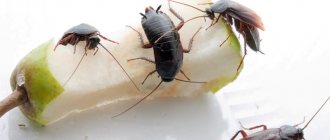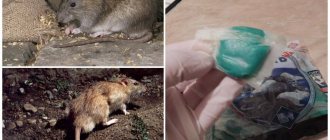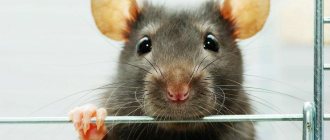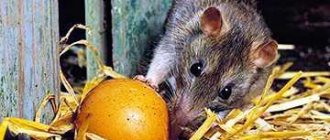Rats often prefer to live in human housing, where there is warmth and enough food. Over the course of a year, one adult animal can eat up to 10 kg of food, and chew and spoil much more.
The pests' strong teeth easily cope with electrical wires, plastic, wood and even concrete.
In addition, rodents carry infections that are dangerous to the human body. A variety of methods are used to control rats. One of them is bait, which helps catch animals.
What to put in the trap?
The main requirement for substances used to catch parasites is a dense structure. Most traps require a treat to be placed on a hook, and the mechanism is released after the animal pulls on it.
Egg yolks or minced meat are not suitable for such cases . The best rat baits have a strong, attractive scent.
Even being far away, the rodent must definitely want to try the prepared delicacy, because for this he overcomes his own fear and caution. Let's look at the most popular baits.
Salo
This is the best bait for rats. Animals really like the product, it has a pleasant and quite persistent smell.
You can put fresh, smoked or fried lard in the rat trap. The most attractive pieces will be those with a meat layer. A salted product is also suitable for these purposes.
Corn
A universal bait for rats, since grain crops are the natural food of mammals. To achieve the desired result, pieces of lard are added. A good option would be a fresh loaf or buns.
To enhance the attractiveness of the product, a few drops of vegetable oil are used. Sometimes small flatbreads are made from grains and flour.
Some owners treat baits with poisons . If the trap mechanism does not work, the animal will die after trying the offered “delicacy”.
Sausages
The product has a distinct pleasant aroma, so it will help lure rats into the trap. Typically, rodents refuse treats containing a large number of artificial additives and avoid traps.
It is better to select natural sausages with a short shelf life. The product is rarely used because such products are expensive. Knowing what to put in the rat trap, you will be able to quickly catch the rodent.
Meat
A small piece of fresh or boiled meat is placed in the rat trap as bait for the rat. You should not use large slices, since the animal is able to gnaw off the edges without touching the hook, then the trap mechanism will not work.
The strong, specific aroma of meat attracts animals located over large areas.
Vegetable oil
This is another product that has a strong smell. It is better to use an unrefined, dark-colored product as bait for rats. Pieces of bread, meat or cotton wool are soaked in oil.
Sesame oil with a pronounced spicy aroma is picked up by rodents from long distances, so it is also suitable for fighting bees.
Sunflower seeds and peanuts
Nuts and toasted seeds are successfully used to catch rodents. Just a few grains are enough. You can also lure a rat into a trap using peanut butter or paste.
The strong smell of these substances, which does not lose intensity over a long time, inexorably attracts mammals. Butter or paste is spread on slices of bread.
Many people are sure that pasyuki adore cheese . Such information is actively imposed by various films and cartoons. Actually this is not true.
Animals prefer food that can be obtained in their natural habitat, and fermented milk products are not found in nature. Despite the fact that cheese does have a persistent, pleasant aroma, it will not make an effective bait.
If the chosen bait does not work within 3-4 days, especially when traps are set in new places every night, it is worth replacing the treat. Any product, even an effective one, must be replaced with a fresh one every couple of days.
Gradually their smell weakens and becomes less attractive to rats. This rule is of great importance when installing tunnel traps with a partially closed structure.
The aroma in this case should be strong enough to go beyond the rat trap and be felt throughout the room. This process takes longer than when using open traps.
When preparing the bait, it is important to never touch it with bare fingers. Otherwise, the rats will pick up the human scent and won’t touch the treat.
Salo
When asked what mice love most, experts answer lard. Rodents can easily recognize high-calorie foods, which they can fill up quickly and for a long time. Lard is considered the most effective assistant in catching mice. To enhance its attractiveness, the treat is lightly fried with a match to make the smell more captivating. It is necessary to use fresh lard with an attractive aroma; the smell of old and stale lard repels them.
To save money, you can put the skin with the remaining lard in the rat trap. Such bait will not deteriorate for a long time and will retain an appetizing smell for the mouse.
The most effective traps
Several of the most effective methods are used to control pests. These are poisonous baits, ultrasonic repellers, mousetraps that kill or catch animals alive, and sticky traps.
Each method has its own characteristics, advantages and disadvantages. To choose the appropriate option, you should consider them in more detail.
Poison traps
Placed in places closest to nests or movement routes of animals. Often made from seeds or grains. Rodenticides can be purchased at pharmacies.
The drugs are made on the basis of substances that block blood clotting. As a result, rodents die from internal bleeding. Such baits should not be used in areas where pets live.
Ultrasonic repellers
This method is considered the most humane and safe for both animals and humans. Such devices produce sounds at a certain frequency.
For humans they are imperceptible, but for rats they are simply unbearable . Some models, in addition to ultrasound, are capable of emitting special sound signals and scaring away beepers using light flashes.
The combination of several effects completely kills the desire of pests to be near such powerful stimuli. In the first few days of using repellers, an increase in the number of rats may be observed, but do not be alarmed, this is a normal reaction.
Ultrasound causes real panic in pasyuki, forcing them to be active during the daytime and chaotic movements around the house. In a couple of weeks the room will be completely cleared of parasites.
Another safe and humane way to control rodents is with essential oils. Animals simply cannot stand the smell of mint and try to stay away from it.
Rat traps
If there are a lot of pests, you can try to catch them with a rat trap. To do this, you need to use the best baits that were listed above.
When setting traps, it is important to ensure that there are no small children or pets nearby.
Compared to poisons, mousetraps have undeniable advantages . A poisoned rat can die anywhere in the house. The corpse under the floor will poison the air with an unpleasant odor for a long time.
Traps with bait for rats are located along the walls, in areas where rodents or traces of their presence have been noticed. Typically traps are placed perpendicular to the wall.
In addition to devices that kill animals, there are also so-called “live traps”. They confine the animal without injuring it. This allows you to release the rat into the wild, the main thing is to do it away from your home.
Sticky traps
Usually used for catching mice, since their weight is much less than that of a rat. The animal, running along its usual routes, ends up on a sticky surface from which it cannot get out.
If such a trap is glued to the body of a person or pet, it can be removed using vegetable oil.
The installed traps are checked every day. All manipulations must be carried out with rubber gloves.
Types of plastic traps
Rat traps are divided into 2 types: killing and humane. Rats are removed from homes because they damage walls, spoil food, and spread disease. The average individual easily makes a hole in a thin-walled plastic pipe; their bite is painful.
Farmers consider such pests to be their first enemies. Rats destroy chickens and other small animals; often these animals kill young piglets. Rodents are dangerous for babies sleeping at night, since hunger forces rats to attack even them. The home owner can use one of two options: make a rat trap with your own hands or purchase a factory product.
This is not to say that homemade traps are better or worse than factory ones, but they open up creative scope for the creator
Vertical device
To make a homemade trap you will need a 2 liter plastic bottle. Experienced rat catchers construct the product according to the following principle:
- Use scissors to remove the neck of the container.
- 2 cm are retreated from the cut part downwards and a hole is made with a needle.
- A fishing line or nylon thread is inserted into the hole and a strong knot is created.
- The second edge of the cord is tied to a mounted object on the kitchen table.
- Bait is placed in the bottle.
This video shows the top 5 best homemade mousetraps:
Horizontal design
Horizontal traps give a good effect. They are installed above a bucket of water. The process of making a killing trap:
- Symmetrical holes are made at the bottom and cap of the bottle. A wooden or metal rod is inserted there, the edges of which protrude 5-10 cm from the container. A trap is placed on them between two objects and secured.
- Bread treated with sunflower oil is attached to the surface of the rotating structure with tape. The bait is placed in the center of the fishing container.
- Since it is difficult for the animal to climb inside the rat trap, a wooden or cardboard ladder is built.
A horizontal trap with a bucket of water is the most effective among homemade ones.
Plastic “trap pit”
Another type of effective device for catching pests, which can be done in a short time. Main material: 5L plastic bottle. Step-by-step construction:
- Step back 10 cm from the neck, draw a line and cut off the excess part.
- A landscape sheet is placed on top of the cut and secured with tape.
- A cross-shaped cut is made in the middle of the paper.
- A stick is made in the shape of the letter “L”, tied to the product and equipped with a bait hanging over the center of the cut.
- A wooden ladder is placed on the structure.
The basic principle of the pit trap is to lure the rat onto a piece of paper with slots in it.
Product made from sharp petals
The principle of operation of a trap is similar to the trapping pit device. You will need a large bottle. Craftsmen do this:
- The top part with the neck is removed from the container. The hole diameter is at least 8 cm.
- Step back 10 cm from the cut and draw a line around the circumference. Using scissors, cut strips 1 cm wide.
- Oiled bread is placed inside the homemade product.
- The edges of the petals are folded into the middle.
- A wooden plank serves as a ladder.
The pest will want to climb inside the container for the bait, put its paws on the petals and fall into the structure. Sharp stripes will prevent the rat from getting out. In one night, the product catches a dozen rodents.
Homemade rat traps
You can make effective traps with your own hands from available materials. You just need to put in a little effort and ingenuity, and the result will not take long to arrive.
Bucket rat trap
It doesn't take much time to create. The base is represented by an ordinary bucket; both metal and small plastic ones are suitable. A concentrated salt solution is poured into the container. The bucket should be fairly stable so that it does not tip over when hit by a rat.
To outwit the animal, you need to pour seed husks and sawdust into the water. A thick layer is not required. The salt will push the contents to the surface and mask the liquid.
Next, bait in the form of slices of sausage or bread soaked in milk is placed in the container. An approach to the bucket is constructed from a thin plank or books, always at an angle. This way the pest will be able to get to the very edge of the container and then fall into the solution.
Fine mesh trap
Made from welded material with small cells. You will need tools with which the mesh is cut into rectangles with parameters 60x30x20 cm. The elements are connected using a welding machine.
The smaller the cell size, the greater the likelihood of catching a rat . For convenient use of the trap, a handle is built on top. In the front part there is a door that operates on a spring.
The bait is placed on a cord with a hook and is located at the back wall of the cage. The second end of the rope is fixed to the door. If the animal touches the treat, the rat trap will slam shut.
Rat trap made from a flowerpot and a plastic strip
No expensive equipment is required to catch pests. It is necessary to take a flower pot or other container with such weight that it cannot be turned over.
One end of a plastic bar or a regular ruler should be sharpened, and an attractive bait is attached to it.
The sharp part is installed on the edge, and a flowerpot is placed on top. One side of it should rest on the bar, the other on the surface of the floor or table in areas where there are especially many rats. Part of the ruler with bait is directed inside the pot.
There is a similar option using a cardboard box and a board. The method is popular because it does not require any cash costs, and similar elements can be found in every home.
Folk recipes
Home methods for rats You can remove rats from the basement using folk remedies as quickly as using store-bought poison. To do this, you need to know what rats are afraid of.
- Ash drives rats out of the cellar, destroys harmful insects, and does not threaten human life. Sprinkle a thin layer over the entire floor of the cellar or along the walls. The ash sticks to the paws and stomach, irritates the skin, and causes a terrible burning sensation. The rat tries to get rid of the pollution, the ash ends up in the stomach. Intestinal upset appears. Pain drives the rodent out of the room; repeated repetition of the situation forces the rodent to look for a new place to live.
- In the basement of a private house, you can get rid of rats with flour and plaster of Paris. A reliable method with minimal costs. Mix in equal proportions and place in a shallow container. When gypsum gets inside, it hardens. Along with it are the internal organs. To make the process go faster, place a container of water in close proximity.
- If there is a rat in the cellar, you can drive it out with specific odors. The rodent cannot tolerate strong aromas. Moisten a rag in kerosene, ammonia, naphthalene, or solvent. Lay out on the floor. You can remove rodents with peppermint, garlic, and pine.
- The rat in the basement is constantly looking for food. You can treat her to a fragrant wine cork fried in lard. It should be crushed first. Give the rodent a treat. The plug in the stomach will begin to swell, lead to significant deformation of the internal organs, and block breathing.
If the rats bypass the poison and do not fall into traps, you can build a trap out of water. Take liquid into a deep container, spread straw on top, pour a few tablespoons of sunflower oil. Scatter wheat grains in the center. Place a ladder to the container. You can catch the biggest rat in a bucket.
Useful tips
To effectively catch rats using baited traps, follow these tips::
- Not only meat, lard, seeds and vegetable oil are used as bait. An excellent substitute would be cottage cheese, boiled rice, and slices of bread. Only fresh and aromatic products are used, otherwise the rodent will not approach them.
- Traps are placed in areas where a large number of pests have been observed. Ideally, right in the hole. But first they find out whether she is residential or not. To do this in the evening, you need to place a crumpled sheet of paper at the entrance. If the leaf is torn or moved in the morning, it means the hole is inhabited.
- Traps are set against the movement of pasyuks. They usually move along walls, as well as in areas where the least amount of light penetrates.
- Rats care about their own cleanliness, so they will prefer to move along a clean path if possible.
- The trap is regularly washed with a solution of baking soda or ash lye, then ventilated and dried. If the mousetrap emits an unpleasant odor, this will only repel rodents.
Rats are cunning, cautious animals, so you have to work hard to catch them. They enter the home through thresholds, sewer pipes, and can climb vertical pipes and walls.
Neighborhood with rodents is unlikely to please anyone, so it is necessary to act immediately after discovering the animals. The listed control methods, traps and baits are sure to give a positive result if the presented recommendations are strictly followed.
Why are rodents “led” to bait?
Rats and mice live where food can be found. Therefore, they settle in a garbage chute, basement, cellar, barn, or even in the kitchen, hiding between the walls. Rodents have a developed sense of smell. They quickly “take the trail” of food and will unmistakably find it, even if the food is hidden in a tin can or bag. The stronger the aroma emanating from the bait, the more likely the pest will come running to it. Mice or rats can eat spoiled food, but they are more attracted to a fresh, flavorful piece of food.
Rodents love to dine on junk food and have a super-acute sense of smell.
What smell attracts mice?
Rodents have poor eyesight, so other senses are highly developed: smell, touch, hearing. Mice are selective eaters. The smell of their favorite foods lures them in, while dangerous substances repel them. To know what to catch rats or mice with and what baits are guaranteed to work, you need to study the scents that attract them.
Rodents like the smells of the following foods:
- bakery products;
- vegetable oils;
- salted fish;
- meat;
- lard;
- sausages;
- snacks (chips, nuts, crackers);
- beer.
Note! The fresher the product, the stronger its aroma. If a mouse smells the chemicals, it will pass by.
Rats are less picky; they eat everything. But if one animal feels bad after eating, the rest will not eat the food.
What is the danger of rats and how can they get into your home?
Being a very prolific species, rats extremely quickly create entire colonies of rodents, which cause significant damage to your harvest and other food supplies. In addition, rodents can act as carriers of infectious diseases that humans become infected by coming into contact with objects on which animals have left microparticles of saliva, droppings and other waste products.
Another threat is a rodent bite. Animals rarely attack people, but if a rodent is driven into a dead end, it can attack a person.
The peculiarities of the rodent's anatomy allow it to penetrate literally into every crack: powerful and strong incisor teeth, the growth of which continues throughout the rat's life, are capable of chewing through even cement.
Prevention
Very often the appearance of rodents has already been provoked. They come into houses from the street, this problem is especially relevant in the fall with the first cold weather. In apartments, these can be places above grocery stores or restaurants. To solve this problem, it is not enough to catch or poison a rat once; you need to take care of prevention:
- Perfect cleanliness. We are talking about small crumbs, garbage, and food leftovers in the sink or on the stove;
- Timely garbage collection. It must always be packed. It is best to take out the bags in the evening, because rodents are nocturnal animals;
- Cereals and other bulk products must be stored in closed containers. It is best to put them in glass or metal jars with durable lids.
Neatness, cleanliness, and attention to every detail helps prevent the appearance of rodents after the rats have been caught or poisoned.
The last factor is repairs. You should definitely try to seal all the holes and cracks through which pets enter the apartment. Modern building materials and techniques make it possible to do this and minimize the risk of such pests.
Why do you need to catch rats?
It would seem that the rat lives for itself and does not bother anyone. Sometimes he runs through the crack to steal a cracker for himself. Everything seems peaceful and harmless. Why catch her?
But rats are far from harmless. They are carriers of dangerous diseases. This is where it’s worth remembering the terrible epidemics in the Middle Ages that destroyed most of the population of Europe. It was rats that were then the main carriers of bubonic plague. Rats multiply quickly, occupying new territories. It is known that one individual is capable of breeding 20 rat pups in a month . This means that rats will need more food and space to live. That is why, having noticed a rodent at home, you need to immediately take measures to protect the apartment from the new neighbor.











